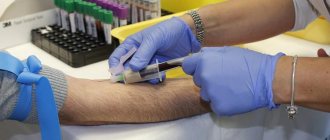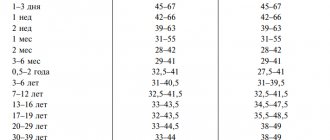INR blood test - what is it?
An INR analysis paired with another indicator called PTI shows the quality of functioning of the blood coagulation system. INR is the international normalized ratio, it is a coagulogram that is calculated using a special formula, it includes the PTI value. PTI – prothrombin index. It shows how long it will take for a patient's blood sample to clot. This value is compared with the established norm, and the percentage of the result obtained to the standard is calculated.
INR, in turn, is calculated from the ratio of the prothrombin index to the standard value of this indicator, and the result is multiplied by the international sensitivity index, which, in turn, is also a given standard.
Together, all these indicators help the doctor understand at what speed the patient’s blood is clotting, whether there is pathology, and in what doses therapy is required for cardiovascular diseases.
Why and in what cases is a study prescribed, its price
Only INR is rarely used to detect bleeding disorders at any specific stage. Typically, disorders in the circulatory system are determined in the laboratory by analyzing other laboratory testing results. Carrying out such studies makes it possible to diagnose and establish the pathology that caused either spontaneous bleeding or excessive thrombus formation.
But much more often it is performed to evaluate the result of a course of indirect anticoagulants. After reviewing the data obtained, the doctor increases or decreases single daily doses, discontinues medications or prescribes analogues with other active ingredients.
Laboratory testing is prescribed to patients if they are suspected of developing the following diseases:
- hepatitis;
- cirrhosis;
- fatty liver;
- cholecystitis;
- oncological pathologies;
- pre-infarction condition;
- chronic hemoblastosis.
People who are indicated for continuous use of indirect coagulants require regular identification of INR parameters. Its deviation from the norm indicates the need for dose adjustment or additional laboratory tests.
The average cost of analysis varies from 200 to 350 rubles. But this is the price of only performing the laboratory procedure itself.
Collection of biomaterial is paid separately. The cost of this service rarely exceeds 150 rubles. If you need results urgently, you will have to pay twice as much.
INR norm
Units are used to express INR. The higher the INR, the less blood contains prothrombin and other factors that affect coagulation. The INR of a healthy person ranges from 0.85 units. up to 1.37 units. At the same time, the patient’s age affects the values of the norms:
- Newborns and children of the first year of life – from 0.9 units. up to 1.25 units
- Children from one to six years old can normally have 0.95-1.1 units.
- In patients aged 12-16 years, the normal INR ranges from one to 1.35 units.
- After 16 years, the value should be within 0.85 units. – 1.3 units.
For those who have already been prescribed anticoagulant therapy, the INR should be between 2.0 units. up to 3.0 units, because drugs that fight the formation of blood clots do not allow the blood to thicken, which also affects the prothrombin index.
If a patient is not taking blood thinning medications, but his INR is higher than normal, this may indicate:
- liver diseases;
- coagulopathies;
- prothrombin deficiency;
- lack of fibrogen;
- vitamin K deficiency;
- taking certain medications that affect blood composition;
A low INR always indicates that a person is at risk. Value below 0.5 units. reports the onset of venous thrombosis.
Preparation for the procedure
It is necessary to properly prepare for the study in order to immediately obtain the correct results.
What can cause false analysis data:
- daily consumption of coffee, alcoholic beverages of any strength, foods high in fat and simple carbohydrates;
- prolonged exposure to the sun;
- excessive physical activity, heavy physical activity during the day before the study;
- collection of biological material from patients who have recently completed chemotherapy or antibiotic therapy.
Blood sampling is performed in the morning. If the patient, for medical reasons, should not skip meals, then the analysis is carried out after 5-6 hours.
Why do you need to know the INR?
INR analysis is a common research method during the diagnosis of cardiovascular diseases. In addition, bleeding and severe thrombus formation are direct indications for studying all parameters affecting coagulation.
Knowing the INR is very important for the cardiologist who prescribed anticoagulants to the patient, since this allows him to control the correctness of the dose calculation, in order not to harm the patient. This also includes taking warfarin, the dosage of which is determined for each patient individually.
In case of cirrhosis of the liver or other disease of the filtering organ, it is also important to know the INR level, because it is the liver that produces many factors that clot the blood.
A separate group of patients are pregnant women. First of all, this is due to the fact that the entire body system begins to work differently during pregnancy. The level of hormones and enzymes changes, and the volume of blood circulating through a woman’s veins increases. Hence the need to control the functioning of the hematopoietic system. Due to the high level of blood clot formation, the likelihood of complications is high. And if the blood is too thin and there is a lack of platelets, there is a high probability of dangerous bleeding during childbirth.
At the very beginning of labor, each woman in labor is given a catheter in a vein, into which, if necessary, an IV will be placed with a composition that increases the level of blood clotting to prevent large blood losses.
Complexes with this research
Male check-up No. 1 39 studies for annual preventive examination RUB 18,570 Composition
Coagulogram Study of the functional state of hemostasis RUB 2,020 Composition
Miscarriage Identification of the main causes of miscarriage RUB 40,070 Composition
IN OTHER COMPLEXES
- For those at risk of COVID-19 RUB 4,510
- Risk of severe COVID-19 RUB 1,090
- Extended coagulogram RUB 4,150
- Female infertility RUB 16,210
- Examination during pregnancy. 1st trimester 16,690 RUR
Do I need to prepare for an INR test?
First of all, you need to remember that blood to determine the INR value is taken from a vein. A prerequisite is on an empty stomach. This means that you cannot eat or drink sugary water 6-8 hours before. At the same time, you should not fast for more than 10 hours before donating blood, as this will distort the data.
The day before the test, you do not need to do heavy physical work. If the patient jogs in the morning every day, before going to the laboratory, you will have to abandon the activity and reschedule it for the evening. Since jogging will affect the speed of blood flow, blood oxygen saturation and its composition.
Any daily medication intake should also be taken into account - the evening dose on the eve of sampling should be taken no later than 17:00. And triple the appointment must be rescheduled, and you need to take the medicine/get an injection after donating blood.
It is recommended to approach the building of the medical institution 15 minutes before the appointed time in order to have time to put your outerwear in the cloakroom, take your time, find an office and calm down before the procedure. Even slight anxiety associated with the fear of being late can affect the composition of the blood.
We must not forget that taking oral contraceptives significantly distorts the actual state of the coagulation systems due to the elements included in the composition that prevent the formation of blood clots. Therefore, an INR test should be scheduled on the fourth day after completing a three-week course of birth control pills. In other words, the test can be taken closer to the end of the week during which withdrawal bleeding occurs. If this is difficult, you must tell the laboratory assistant the name of the drug you are taking so that he takes its effect into account when calculating the result.
Analysis transcript
If the INR is elevated, this indicates the possibility of the following pathologies:
- hereditary pathology of the coagulation system;
- improper absorption of fats in the intestines;
- vitamin K deficiency;
- liver diseases;
- side effects from taking indirectly acting drugs.
An overestimated value is dangerous due to the risk of internal and external bleeding. An indicator above 5 is especially critical. The situation is complicated if the INR is higher than normal when diagnosing hypertension, ulcerative lesions of the gastrointestinal tract, and diseases of the urinary system. In this case, the patient requires urgent hospitalization and treatment.
A coagulogram in which an underestimated INR reading is observed indicates the development of the following conditions:
increased antithrombin levels,
side effects from taking diuretics and contraceptives,
abnormal hematocrit level.
A low index indicates increased blood viscosity, which can result in the formation of blood clots in the vessels.
If a low INR is detected in a pregnant woman, this indicates the likelihood of thromboembolic complications. Any violation of the norm of the indicator signals a malfunction in the body, as well as a possibly incorrectly selected dose of medications taken.
Warfarin, expected effect of taking the drug
Warfarin is a representative of the clinical and pharmacological group of indirect-acting anticoagulants. The drug is produced by many domestic and foreign manufacturers in the form of tablets.
The active ingredient blocks the production of major blood clotting factors by liver cells. The result is a decrease in their quantitative content in the systemic circulation and slower blood thickening.
Let's watch a video about what results are expected from taking Warfarin:
How are the analysis results deciphered?
Calculating the INR value is quite simple - it is inversely proportional to the time period during which the blood completely clots. High parameters indicate low levels of prothrombin in the systemic circulation. There is also a deficiency of clotting factors responsible for optimal thrombus formation.
The generally accepted normal value is 0.85-1.15 for people in good health. In the presence of diseases requiring the use of indirect coagulants, parameters 2-3 are taken as the norm.









